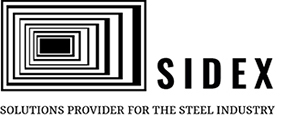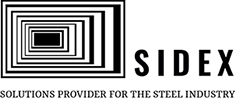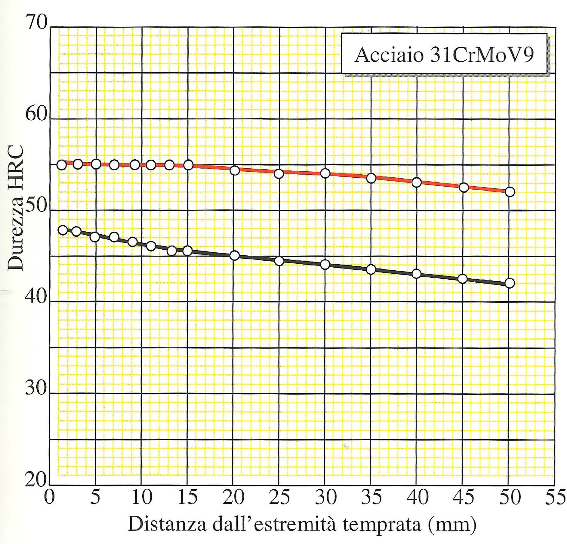31CrMoV9
31CrMoV9
Normativa di riferimento UNI EN 10085– corrispondenza DIN W.1.8519
Reference standard UNI EN 10085 – Number DIN W.1.8519
Dati tecnici dell’acciaio
È un acciaio da nitrurazione legato al CrMoV di elevata temprabilità, buona tenacità anche dello strato nitrurato, e basso contenuto di carbonio, adatto alla fabbricazione di pezzi di grandi dimensioni sottoposti ad elevate sollecitazione dinamiche o pulsanti. Possiede discreta lavorabilità ed è poco sensibile alla precipitazione intergranulare di placche di nitruri nello strato nitrurato, che tuttavia non raggiunge una durezza molto elevata (700÷800HV). Per queste proprietà è usato per fabbricare cilindri di plastificatori bivite e canne di cannoni da guerra, dove è richiesto uno strato nitrurato molto profondo (anche 1 mm) e tenace, anche se non particolarmente duro.
Grade technical data
It is a nitriding steel alloyed with CrMoV, it possess high hardenability, good toughness even in the nitrided layer, and low carbon content, suitable for the manufacture of big parts which are subject to high dynamic or pulsating stresses. It has a reasonable workability and is not very sensitive to intergranular precipitation of nitride plates in the nitrided layer, which however does not reach a very high hardness (700 ÷ 800HV). For these properties it is used to manufacture twin-screw laminator cylinders and war cannon barrels, where a very deep layer is requested (even 1 mm) and tough, even if not particularly hard.
Composizione chimica
Chemical Composition
| C% | Mn% | Si% | S% | P% | Cr% | Mo% | V% |
| 0,27÷0,34 | 0,40÷0,70 | ≤0,40 | ≤0,035 | ≤0,025 | 2,30÷2,70 | 0,15÷0,25 | 0,10÷0,20 |
Caratteristiche meccaniche del nucleo
Mechanical Properties of the core
| Stato
State |
Ø barrotto mm
Ø of sample mm |
Rm
N/mm2 |
Rpo,2 min
N/mm2 |
A5 min
N/mm2 |
KV min
J |
HB a nucleo
HB at core |
HV1 superficie
HV1 surface |
| Ricottura subcritica
Subcritical annealing |
≤ 825 | ≤250 | |||||
| Ricottura isotermica
Isothermal annealing |
≤795 | ≤240 | |||||
| Bonifica
Quenching and tempering |
16<Ø≤40
40<Ø≤100 100<Ø≤160 160<Ø≤250 |
1100÷1300
1000÷1200 900÷1100 850÷1050 |
900
800 700 650 |
9
10 11 12 |
25
30 35 40 |
330÷380
300÷355 275÷330 255÷315 |
|
| Nitrurazione – Nitriding | ≥ 750 |
| Temperature consigliate per lavorazioni e trattamenti termici
Suggested temperatures for workings and heat treatments |
||
| Operazione eseguita
Operation carried out |
Temperatura °C temperature °C |
Mezzo di spegnimento
Quenching media |
| Lavorazione plastica a caldo – hot plastic working | 1000÷900 | Aria – air |
| Ricottura subcritica – subcritical annealing | 680÷750 | Aria – air |
| Ricottura isotermica – isothermal annealing | 830÷850
700 x 4h |
Forno – oven
Aria – air |
| Normalizzazione – Normalization | 880÷910 | Aria – air |
| Tempra in olio – Quenching in oil | 870÷910 | Olio – oil |
| Rinvenimento di addolcimento – Softening tempering | 570÷650 | Aria – air |
| Nitrurazione – Nitriding | 480÷570 | Atmosfera controllata
Controlled athmosphere |
Banda Jomini
temperatura d’austenitizzazione consigliata 900 ± 5°C
Jomini curve
austenitization temperature suggested 900 ± 5°C








